PIRACY – 1
I have promised to write something about piracy in the form of shortish mini-essays embedded within articles about my sailing life. Here’s my first effort.
The word piracy and its associated grammatical forms has multiple meanings in modern usage. It can refer to murder on the high seas or the use by an unauthorised person of some-one else’s copyright – as in – “A pirated copy of a film or book”. I shall use it in its classical sense, meaning “Robbery or criminal violence on or near the sea”. It is in essence a form of warfare carried out by people of a particular group who do not obey its laws, or by members of another group altogether. It has been practised for a very long time indeed.
PROPERTY AND LAW
An understanding of the words robbery and criminal depends upon pre-existing concepts of what “property” and “law” mean. Those ideas only became established in a formal sense relatively recently in man’s evolution. Writing had to be invented first and according to the British Library that happened independently in at least four places far-flung around the world – between about 3,000 and 5,500 years ago.
The first signs that have been found date back to the Sumerians who built cities in Mesopotamia (the “Land between the rivers” roughly delineated by the boundaries of modern Iraq). Their invention was followed by ones made by the Egyptians, the Chinese, possibly the people living in the Indus valley and certainly those of Central America. A fifth possibility in a later era is that the original inhabitatants of Easter Island may also have developed some form of writing but there are more theories than facts about the early years of human habitation there let alone those about whether the few markings that have been found were or were not writing. In any event, there is little or no evidence of any linkage between any of these different systems of recording speech.
The first indication of written laws that we have are those of King Ur-Nammu who decreed late in the Sumerian period, around 2,100 BC, that
- If a man commits a murder, then that man shall be killed
- if a man steals, then that man shall be killed
- If a man commits kidnapping, then he shall be forced to pay 15 shekels of silver and will also be imprisoned
Matters became a bit more organised when King Hammurabi of Babylon developed the idea about 350 years later and had 82 edicts carved onto a stone that was found in 1901 and is now on display in the Louvre.
I think its reasonable to assume rulers in other civilisations that invented writing of their own also used it to record the laws they wished their subjects to observe.
That tradition was certainly continued by the Israelites when Moses brought down from the mountain the Lord’s Ten Commandments on Tablets of Stone. They were remarkably similar to some of those introduced by Nammu and Hammurabi. In Old Testament times the penalties for breaking them still applied Ur-Nammu’s principle of “an eye for an eye …..”. The same idea was also carried forward in Dante’s Inferno written in the early 1300’s, and in W S Gilbert’s libretto for the Mikado written in the late 1800’s. Greater priority is sometimes given to rehabilitation than to punishment these days and its often thought uncivilised to “Make The Punishment Fit the Crime”.
The existence of laws and penalties for breaking them demonstrates there’s a high probability that not every-one in these early civilisations behaved in the way their rulers wanted and a further likelihood some criminal acts were carried out at sea soon after boats were invented.
THE EGYPTIANS, GREEKS AND ROMANS
That probability is confirmed by Ramesses II records of attacks by “Sea Peoples” from 1200-1100 BC. These may have been more than pirate attacks as we understand them since some accounts describe the movement of large numbers seeking new lands to settle – apparently immigration was a problem 3,000 years ago – they had “Boat People” in Ancient Egypt too!
In the early days of the Grecian era, raiding to kill men and capture women and children for sale as slaves was common and a perfectly normal and acceptable way of life according to Homer’s poems. By the mid-millenia BC that was frowned upon and the Greeks had a word for people who lived that sort of life – Peirates – usually translated as Brigands in modern english.
The Romans had a lot of trouble with sporadic attacks from the sea, particularly from Illyria which we know as Albania, Serbia, Kosovo, Montenegro and Bosnia – there’s been trouble in the Balkans for a very long time. The Romans adapted the older Greek word and called these people ‘pirata’ whence we get our modern word ‘pirate’.
THE VIKINGS
The Norsemen were great seafarers, warriors and colonisers but I won’t say any more about them now because they also feature at the end of this article in my account of Alchemi’s visit to Oslo.
1997 CRUISE Leg 3 continued
My original narrative and images described the complete leg of Alchemi’s 1997 cruise from Copenhagen to Oslo but became too long for a single article. Please read part 16 of this series in conjunction with this article if you would prefer to read the complete story of this leg of the cruise in one session. To remind the reader of the geography of this coast here again is the map for this leg with the same alert about the misleading impresssion shown on it – ” The island of Sjaelland is continuous and it only looks as though the land north of the word Copenhagen is a separate island because of the white box in which it is written’

BOVALLSTRAND, GREBBESTAD, AND ROCK MOORINGS
It would have been possible to dedicate an entire sailing season to the Bohuslan archipelago if my programme had allowed and I had made arrangements to store the yacht locally during the winter months. There are so many islands, fjords, places to visit and things to see one wouldn’t get bored.
I felt that was particularly true of the area around Lysekil but alas, we had only two weeks for this entire section of the voyage and had to move on via the open sea to maintain our schedule. Bovallstrand is only about 25 miles going that way, has an austere but beautiful approach, and the town itself nestles in a well-protected bay.
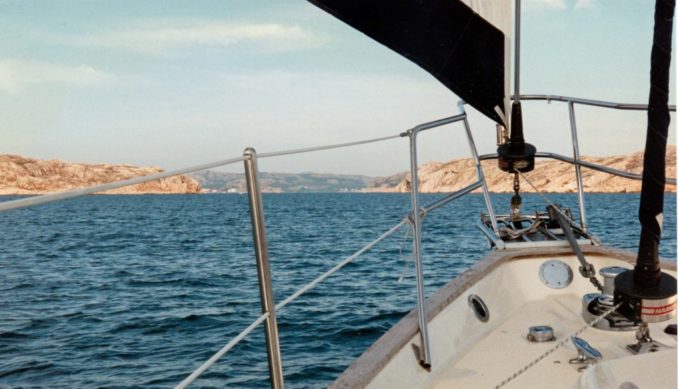
Bovallstrand is a place of modest size with just a few local shops around the harbour and residents’ houses spread across the hills behind. It too is a holiday town with a fine beach but is much smaller and has a very peaceful atmosphere in comparison with Lysekil. We liked it very much and only missed supper in a restaurant beside the jetty because our English crewlady had one of her own fits of Haut Cuisine creativity – with its normal superb result.
The weather changed dramatically on Monday 8 July and we had to beat against a stiff north west wind under deeply reefed sails in steadily rising seas. We ended up sailing almost twice as many miles as the distance covered in our chosen direction and were late arriving at Grebbested’s crowded harbour reminiscent more of Lysekil than of Bovallstrand.
In the morning there was a light breeze blowing away from the pontoon so it was easy to remove our lines, pull out the jib and move off the German boat against which we were rafted with no noise at all. Just as we were executing this manoeuvre the German sailors emerged from their cockpit ready to wake us with a knock on our hull and watched open-mouthed as we sailed away. As they had a much larger yacht and motored everywhere they soon overtook us but we still felt morally superior.
Our one and only attempt at a rock-mooring wasn’t so elegantly performed.
This technique is popular with local sailors but difficult to execute. It entails moving directly towards a steep rock that continues beneath the surface so depth is not a significant worry – but any underwater projections from it might be. The procedure has some similarities with “Mediterranean” mooring to a stern anchor but with the big difference that a crew member steps off the bow onto a rock whilst carrying a bow line instead of onto a pontoon, thus combining the two sports of sailing and rock climbing.
Sometimes that’s not quite as difficult as it sounds because the rock isn’t always vertical and sometimes there’s a piton driven into a crevice to which the line can be fixed instead of having to search for a suitable spike around which to cast a belay. By these means we just about managed to moor Alchemi with our English crewlady handling the stern anchor and rope, me on the wheel and throttle to control boat movement, and our American member on the bow. We even managed to get everyone ashore for a short time.
We weren’t there for very long though before a light cross-wind developed and I became concerned at how we were going to get off again. The hole in the piton was pretty small, we hadn’t used a carabiner that we could leave behind and I worried the rope we had passed through the piton itself would jam if we just pulled it, that the stern anchor would drag in the cross-wind and that the side of the boat would crash into the rock face above or below the water-line – whose idea was this anyway? – the idiot!
In the end, I had the engine running, the English crewlady holding the warp to the stern anchor ready to pull us away from the rock on which the American was still standing ready to temporarily hold the boat from swinging to leeward in the breeze when the line was released. I went forward to check our readiness to leave and was half way back along the side-deck to operate the engine and rudder controls when a plaintive cry went up from behind me – “I can’t hold her”! Without looking back I continued at full speed to the cockpit calling out “Get On”! That advice and sheer fright were sufficient for our American crewlady to clear the pulpit rail by a wide margin and we were soon far enough away from the rock to feel safe again.
We didn’t try rock-mooring again and having had enough excitement for one day settled for an engine-driven ride up the channel known as the “Motorway of the Sea”. This lived up to its reputation with the narrow passage between islands being crowded with an almost continuous line of yachts in each direction.
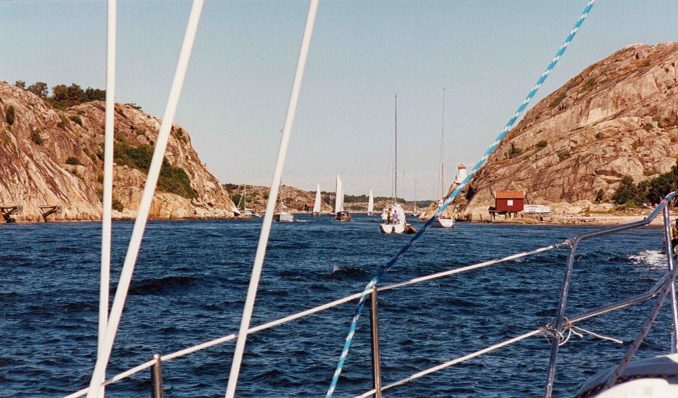
A MOUNTAINEERING AND SAILING DIGRESSION
Unsurprisingly, our experience was trivial in comparison with those of the “Greats” such as Bill Tilman who led a number of expeditions in the High Himalayas in the 1930’s. He didn’t return after WW II because he thought “The Himalaya are getting too crowded.” Instead he bought a yacht (a retired Bristol Pilot Cutter), recruited young adventurous crews , and went Exploring and Mountain Climbing in the Arctic and Antarctic. In commemoration of his achievements “The Royal Cruising Club” awards the Tilman Medal to people who have made an outstanding voyage in High Latitudes.
The Reverend Bob Shepton, who is a year older than I and had a yacht just one foot shorter than Alchemi, has been awarded the medal twice – in 1998 and 2009. One of his best known expeditions was in 2010 when he took with him to Greenland a team of expert climbers who made several first ascents of Mountains and Rock Walls using his yacht as a Base Camp. I’ve copied the last link from one on his website reproducing an article he wrote for the April 2011 Issue of ‘Yachting Monthly’ magazine that contains some amazing photos guaranteed to set adrenaline flowing and pulses racing in anyone imagining themselves in the situations depicted.
In 1997, after one year of yacht ownership and the previous 12 months learning about sailing, my own need for adrenaline and a rapid pulse had been satisfied by our mini-experience when trying to rock-moor.
STROMSTAD AND HORTEN
Stromstad is the last town of any size on this Swedish coast and Horten a modest town half way up the Oslo Fjord.
Like Lysekil and Grebbestad, Stromstad is a large holiday town. It was heaving with people and yachts in early July and we had difficulty finding a place to stay. In the end we settled for a yacht haven a considerable distance from the centre of town and a berth well removed from the showers and toilets. These factors deterred us from visiting the town centre. We ate on board and were away again early the following morning.
It was a lovely sunny day sailing in the right direction in a light breeze over a calm sea. The wind dropped completely in the late afternoon and we had to motor the last few miles to Horten. My Swedish charts didn’t extend beyond the border and neither of the two detailed British Admiralty charts of the Oslo Fjord showed where the main marina was located. Consequently, when we went into the Inner Harbour we found ourselves moored at a place with no shore facilities and at some distance from the town.
We were compensated for this isolation by a visit from an elderly gentleman who, having seen our Red Ensign, had come along the pontoon from his own yacht to welcome us to Norway. We much enjoyed a half-hour or more with this new friend who not only gave us lots of useful information about the names and locations of places in Oslo harbour but repeatedly told us
“how pleased he was to see a British Ensign instead of the more usual foreign vessels whose flags have three horizontal stripes”
That old gentleman is probably no longer with us but it was heart warming to realise Norwegians of that era were still so appreciative of the UK’s efforts during WW II. That generation really hated the Nazi occupiers and local collaborators who committed the same sort of atrocities in Norway and Denmark that they did elsewhere (Sweden remained neutral and did in fact have a number of Nazi sympathisers as fictionalised in the popular thrillers, “Girl with the Dragon Tattoo” etc by Stieg Larsson).
OSLO
Oslo Fjord is not nearly so deep-sided as others on the country’s north-western coast but the winds in it are just as fickle so we had to motor all the way from Horten to the capital city.
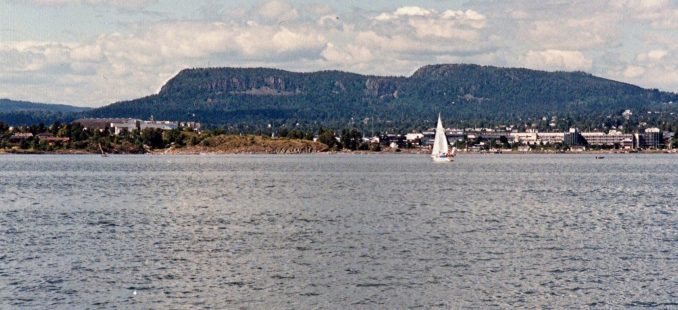

Kongen harbour had no free berths and we didn’t fancy the cost and crowds in the city centre marina at Akker Brygge. Uncertainty about where to stay was soon removed by the arrival of a very persuasive gentleman in an outboard driven skiff who had obviously been listening to our VHF calls. Soon we were moored at a yacht club and had purchased a half-dozen second hand Norwegian charts.
There was a mobile ‘phone signal here and I learned arrangements for the next leg to Bergen would not work out as planned with one definite cancellation and another that was now uncertain. On a positive note my companion from leg 2 in south eastern Sweden was keen to come again and a definite arrangement for that was quickly finalised at the last minute.
My companions who joined in Copenhagen stayed on board for the first night Alchemi was in Oslo but went off to explore the city the next day as I worked away at clearing up Alchemi and preparing her for the next leg. They also arranged to stay for a few days at a B&B so they could continue as regular tourists before returning home to the UK and US respectively. On the second full day we all went on a visit to two museums that for me constituted the highlights of my time in the City.
THE VIKING SHIP MUSEUM
The Vikings were a remarkable people whose civilisation was deeper and more complex than many now appreciate. They were often farmers, craftsmen and traders who only turned to raiding and warfare during times of the year when they couldn’t carry on their normal lives, and when driven to do so by over-population.
The population pressures also resulted in overseas settlements and colonies as far afield in the west and south as France (the Normans were Viking descendants), England, Scotland, Ireland, Iceland, Greenland, North America, Spain and North Africa. In the East they took their longboats down the major European rivers of the Danube, Dnieper, Don and Volga to reach the Black and Caspian seas with settlements in many countries such as the Ukraine and the Byzantine Empire centred on Constantinople where they formed an elite unit of the army known as the Varangian Guard – operational as late as the 14th century.
Interestingly the word ‘Viking” was also used in some Middle Eastern cultures to mean “Pirates”, but it isn’t easy to distinguish fact from myth as the traditions were romanticised in the nineteenth century when some people saw them as “Noble Savages”. Apparently the image of them wearing horned helmets is one example of this that became more widespread after it was first introduced by the Costume Designer preparing for a Wagnerian Opera who adapted it from an artist’s imaginative painting to increase the visual drama of the performance.

Petter Ulleland, CC BY-SA 4.0, via Wikimedia Commons
In contrast to that it is believed the mental images we have of deceased Chieftains being cremated at sea in a ball of flames as their longships were converted into funeral pyres has a factual basis. But sometimes such ships were hauled ashore to be used as tombs for high ranking people.
The fully clothed body of the deceased was laid in his or her boat with many artefacts that might be needed in the afterlife. The Viking Ship Museum in Oslo has on display three longboats, and many household items, tools, weapons and jewellery found during archaeological “digs” on sites around the Oslo Fjord. These have enormously enhanced our knowledge and understanding of Viking skills and way of life.
It will be noted the boats were steered by a long oar called a Stoer mounted near the stern on the right hand side when looking forward. Before rudders on a boat’s centre-line were developed such craft were always moored to a wharf on the opposite side, the larboard, to avoid damaging the Stoer. That is the origin of our modern term Starboard. I’m not sure when the term larboard was introduced but in the the British Navy that name was officially changed to Port in 1844 to avoid confusion between commands shouted in high winds and because places with loading and unloading facilities were so-named.
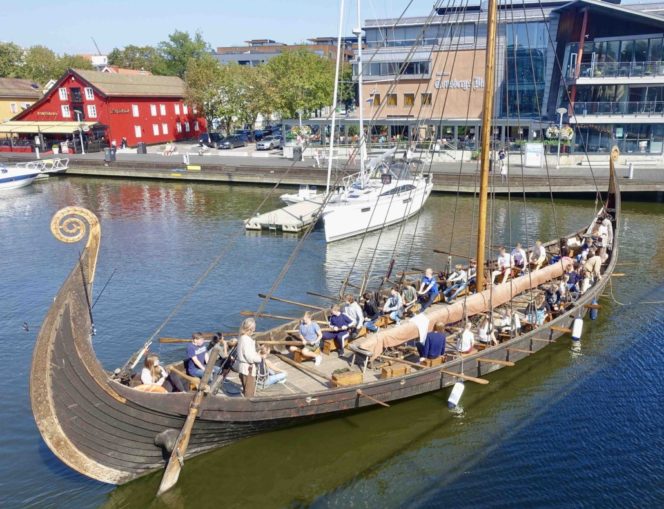
THE KON-TIKI MUSEUM
Thor Heyerdal was the son of a Norwegian beer-brewing family. He is most famous for having demonstrated the population of some Pacific Islands could having originated in South America. He did this by building a Balsa Wood raft and sailing it across the ocean in 1947.
He named the raft “Kon Tiki” and wrote a book about this adventure. I chose a copy as my prize for coming top of my class in French when 12 years old because I was so inspired by his story and achievement. I later learned he had also spent a year with his new wife living under primitive conditions on Fatu Hiva Island in the Marquesas to which I sailed in 2003. A Tiki is an ancient statue of which many examples still exist in the Polynesian Islands. Here is a photo of one on Hiva Oa that I took myself.
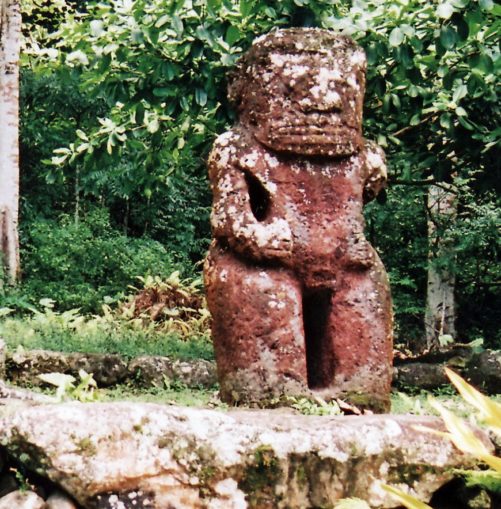
Heyerdal later went on to demonstrate the equivalent could also have been true of North African peoples migrating to Central and South America. He did that by building a raft named Ra, using reeds and other materials and technology available to the ancient Egyptians. He had the raft transported to Morocco and successfully sailed it from there across the Atlantic to the Caribbean.
Heyerdal never claimed this was how populations had actually moved from one continent to another, taking with them the knowledge and skills to build Temples and Pyramids. He said only that he’d shown they had the knowledge, materials and technologies that would have enabled them to do so if they had been motivated to try – but surely he must have hoped the idea that they might have done would later turn out to be true.
Sadly for this romantic dream, modern research shows pretty clearly migrations in the ancient world were more from west to east than the other way around. Scholars nowadays believe the ancestors of the Amerindians came across a land bridge from Northern Asia to North America and then down the continents from there into Central and South America. They also think the Pacific Islands were populated by people from South East Asia with amazing navigational skills and seamanship migrating to Raiatea in French Polynesia and then spreading out from there in all directions to other island groups including Hawaii and New Zealand.
Both the rafts built by Theyerdal are on display in the Kon Tiki Museum situated just a few yards from the Viking Ship Museum.

Bahnfrend, CC BY-SA 4.0, via Wikimedia Commons
To be continued …………….
© Ancient Mariner 2021
The Goodnight Vienna Audio file



